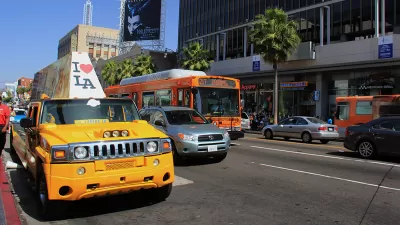Los Angeles Department of Transportation General Manager Seleta Reynolds discusses her vision for urban mobility and the growing role of city leadership.

Mobility in the city of Los Angeles is taking center stage next week as voters will decide on Measure M, a half-cent sales tax increase for public transportation and traffic improvement efforts. To capitalize on those investments, L.A. needs a paradigm shift to embrace technologies and innovation.
In an exclusive interview with The Planning Report, LADOT GM Seleta Reynolds discusses how city departments of transportation are transitioning from focusing on infrastructure-delivery to managing people’s mobility. Reynolds joined TPR to explain some of the most innovative features of her department’s recently released Urban Mobility in the Digital Age report. Reynolds describes the megatrends she is seeing in transportation innovation, such as shared mobility (including Uber/Lyft, bike-sharing, and car-sharing) and the increasing connectedness of vehicles.
The report looks to address the future of transportation in Los Angeles, for example assessing the role of autonomous vehicles, the growing incorporation of connected devices, and how best to utilize cloud-based software. With the passage of Measure M, LADOT will be working with the Los Angeles County Metropolitan Transportation Authority on how best to fund upwards of $100 billion in smart transportation infrastructure.
Reynolds explains how her agency is taking a leading role in embracing new technologies, drafting new rules to accommodate disruptive demand-response technologies and active transportation. Los Angeles DOT was one of just two cities to participate in the recent California Department of Motor Vehicles hearing on regulating autonomous vehicles. As Reynolds has been proactive, she has also been cautious of the role of new technology, stating: “it’s easy to become hypnotized by new technology and to forget that we don’t care about technology for technology’s sake; we care about it because it gets us to our goals faster. We have to be very disciplined in our recognition that new technologies can be great tools, but they make terrible masters.”
As Reynolds hits her two-year mark atop the agency, she explains that bringing in experts from different fields has led to a more holistic approach, as evidenced by the Urban Mobility plan. She explains that “the power of the plan is that it was written by an architect, Ashley Hand, who has a strong sensibility of the quality of the design of our cities and about public spaces and the public realm, and who cares about solving issues like traffic crashes and the horrible inequity across a lot our cities.” Reynolds also explains that the Urban Mobility plan takes on new issues such as planning for aging as Angelenos increasingly age in place.
FULL STORY: “Mobility as a Service” Central to LADOT’s New Urban Mobility Vision

Planetizen Federal Action Tracker
A weekly monitor of how Trump’s orders and actions are impacting planners and planning in America.

San Francisco's School District Spent $105M To Build Affordable Housing for Teachers — And That's Just the Beginning
SFUSD joins a growing list of school districts using their land holdings to address housing affordability challenges faced by their own employees.

The Tiny, Adorable $7,000 Car Turning Japan Onto EVs
The single seat Mibot charges from a regular plug as quickly as an iPad, and is about half the price of an average EV.

Seattle's Plan for Adopting Driverless Cars
Equity, safety, accessibility and affordability are front of mind as the city prepares for robotaxis and other autonomous vehicles.

As Trump Phases Out FEMA, Is It Time to Flee the Floodplains?
With less federal funding available for disaster relief efforts, the need to relocate at-risk communities is more urgent than ever.

With Protected Lanes, 460% More People Commute by Bike
For those needing more ammo, more data proving what we already knew is here.
Urban Design for Planners 1: Software Tools
This six-course series explores essential urban design concepts using open source software and equips planners with the tools they need to participate fully in the urban design process.
Planning for Universal Design
Learn the tools for implementing Universal Design in planning regulations.
Smith Gee Studio
City of Charlotte
City of Camden Redevelopment Agency
City of Astoria
Transportation Research & Education Center (TREC) at Portland State University
US High Speed Rail Association
City of Camden Redevelopment Agency
Municipality of Princeton (NJ)



























